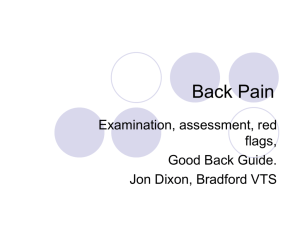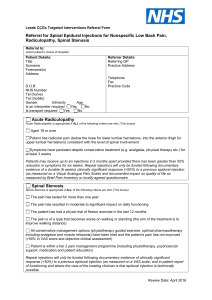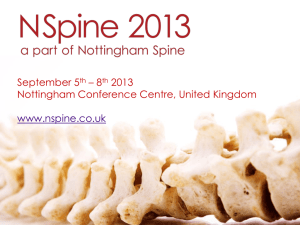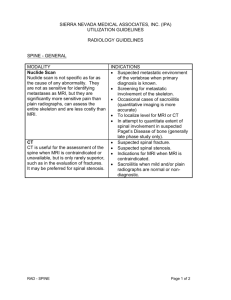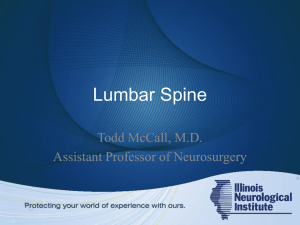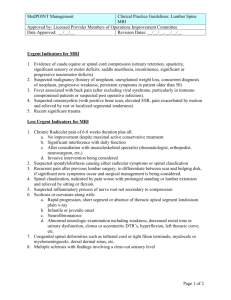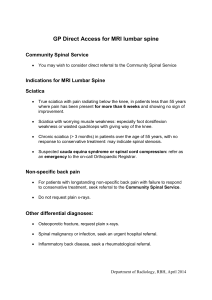spinal stenosis - Oregon Health & Science University
advertisement
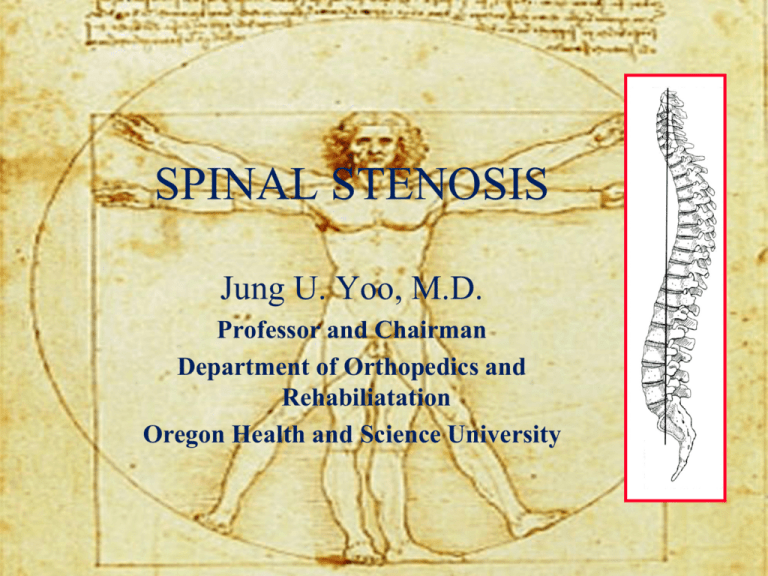
SPINAL STENOSIS Jung U. Yoo, M.D. Professor and Chairman Department of Orthopedics and Rehabiliatation Oregon Health and Science University STABILITY • ORDINARY ACTIVITIES MAY GENERATE OVER 1000LB OF FORCE MOTION NEUROPROTECTION • SPINAL CORD • NERVE ROOTS PATHOPHYSIOLOGY • “Three-joint Complex” – a large tripod with the disc as the front support and two facet joints as the back supports – Any alteration in one of these joints can lead to damage to the others STENOSIS STENOSIS FORAMINAL STENOSIS • Compresses the exiting nerve root CANAL SHAPE • Round • Triangular • Trefoiled (15%) • Trefoiled & asymmetric DEGENERATION & STENOSIS PREVALENCE • Most common indication for spinal surgery in patients over 60 y.o. • 400,000 Americans are estimated to have spinal stenosis STENOSIS • Narrowing of the spinal canal or neuroforamina • causing a symptomatic compression of the neural element. SYMPTOMS • • • • • Neurogenic claudication Radicular pain Weakness Sensory abnormalities Back pain PHYSICAL FINDINGS Physical Finding • Limited lumbar extension • Muscle weakness • Sensory deficit • Literature Review 66-100% 18-52% 32-58% Katz JN, et al: Diagnosis of lumbar spinal stenosis. Rheum. Dis. Clin. North Am. 20:471-483, 1994 NEUROGENIC CLAUDICATION • Cardinal symptom of lumbar stenosis • Progressive pain and/or paresthesia in the back, buttock, thigh and calves brought on by walking or standing, and relieved by sitting or lying down with hip flexion POSTURE AMBULATION DIFFERENTIAL DIAGNOSIS • • • • • • Vascular claudication Osteoarthritis of hip or knee Lumbar disc protrusion Intraspinal tumor Unrecognized neurologic disease Peripheral neuropathy FORAMINAL STENOSIS • • • • Root symptoms Unilateral No claudication Acute or chronic LATERAL RECESS STENOSIS • • • • Claudication Radicular pain Weakness is rare Acute or chronic CENTRAL STENOSIS • Varied presentation • Classically with neurogenic claudication • Some may only have back pain • Rarely painless progressive weakness DIAGNOSTIC TESTS X-RAY • Screening exam • Stenosis cannot be diagnosed X-RAY • Instability such as scoliosis or listhesis CT SCAN • Difficult to diagnose stenosis • Replaced by MRI • May be useful for those who cannot have an MRI CT SCAN • Excellent bony detail MRI • Non-invasive • Soft tissue visualization • Gold standard MRI • Sagittal images • Visualization of foramen MYELOGRAPHY • Excellent for intra-canal pathology • Poor for foraminal pathology • Replaced by MRI MYELOGRAPHY • • • • Invasive 1% spinal headache Recurrent stenosis Inability to obtain MRI MYELOGRAPHY CT-MYELOGRAPHY • Excellent visualization of spinal canal CT-MYELOGRAPHY • Excellent for recurrent stenosis • Invaluable in surgical planning MRI • • • • Expensive Patient cooperation Claustrophobia Open MRI EMG-NCS • Differentiation between neuropathy and radiculopathy • Acute active denervation vs. chronic denervation TREATMENT NONOPERATIVE RX • • • • • • Rest Analgesic Oral steroid Physical therapy Bracing Spinal injection REST • Short term activity modification for acute pain • Long term activity modification is not recommended ANALGESIC • • • • NSAIDS Tylenol Narcotics Neurontin Oral Steroid • Effective for acute pain • Short duration therapy • ? Chronic or repeat tapering dose PHYSICAL THERAPY • Avoid extension exercises acutely • William Flexion Exercises • Water aerobics • Strengthening of weak muscle groups SPINAL INJECTIONS • Epidural steroid • Transforaminal root block • Facet joint injection EPIDURAL STEROID • • • • Commonly prescribed 50% short-term efficacy Not as selective May not require fluroscope TRANSFORAMINAL ROOT BLOCK • Highly selective • Diagnostic as well as therapeutic • Delivers medicine to the floor of spinal canal FACET INJECTION • Facet for back pain • Not for radicular pain • May act as epidural in 40% of cases SPINAL INJECTION • Most effective for acute pain • May not be indicated in cases of acute denervation or progressive motor loss OPERATIVE TREATMENT • Decompression of neural element • Stabilization of unstable segment “LAMINECTOMY” DECOMPRESSION OF LATERAL RECESS • Undercutting the ventral aspect of the facet joints and the associated ligamentum flavum. • Medial facetectomy if necessary • The traversing nerve root underneath the facet joint must be visualized FUSION • • • • Sagittal instability Scoliosis Iatrogenic pars defect Greater than 50% facet joint resection INSTRUMENTATION Thank you
